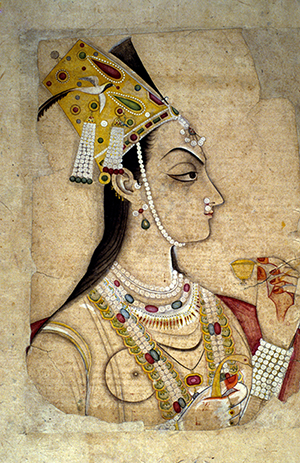Find out more about The Open University's History courses and qualifications
| Nur Jahan | India | 1577 - 1645 | Imperial Rule |
 Portrait of Nur Jahan
In seventeenth-century northern India, upper-class women’s movements were very much restricted by the rules of purdah, that is, the seclusion of women from public view behind high-walled screens and curtains within the home. It is all the more remarkable then, that during the reign of the fourth Mughal Emperor Jahangir, real power was known to be exerted by his favourite wife, Nur Jahan.
Portrait of Nur Jahan
In seventeenth-century northern India, upper-class women’s movements were very much restricted by the rules of purdah, that is, the seclusion of women from public view behind high-walled screens and curtains within the home. It is all the more remarkable then, that during the reign of the fourth Mughal Emperor Jahangir, real power was known to be exerted by his favourite wife, Nur Jahan.
Born to a Persian family, Nur Jahan was brought to court as a widow in 1607, to serve as lady-in-waiting. Reputedly very beautiful, she attracted the attention of the Emperor and they were married in 1611; she would be Jahangir’s twentieth and last legal wife. During the next ten years, assisted by trusted men like her father and brother, she assumed all the rights of sovereignty and government. It is said that Jahangir’s addiction to alcohol and opium, and preference for artistic pursuits made him dependent upon her to rule in his name. She controlled all matters of government and had coins struck in her name.
She has been portrayed as a schemer who took advantage of her husband’s addiction to take power. But evidence also points to her physical strength and courage, a talent for administration, and responsibility for the many artistic, architectural, and cultural achievements of Jahangir’s rule. She designed the gardens of Kashmir and Agra and was a patron of poetry. She took a special interest in women’s affairs and provided land for women and opportunities for orphan girls.
Jahangir’s failure to name an heir before his death in 1627 led to a power struggle amongst his sons. Nur Jahan’s power weakened and she was confined by Jahangir's third son, Shah Jahan. Her imprisonment ended her influence at court, and she spent her final years in exile in Lahore.
 This article is part of the world-changing women collection. All the articles in this collection are specially produced for the How women changed the world interactive tour created to reveal the untold stories the history books left out.
This article is part of the world-changing women collection. All the articles in this collection are specially produced for the How women changed the world interactive tour created to reveal the untold stories the history books left out.
You can also view these articles without the interactive feature here.



Rate and Review
Rate this article
Review this article
Log into OpenLearn to leave reviews and join in the conversation.
Article reviews